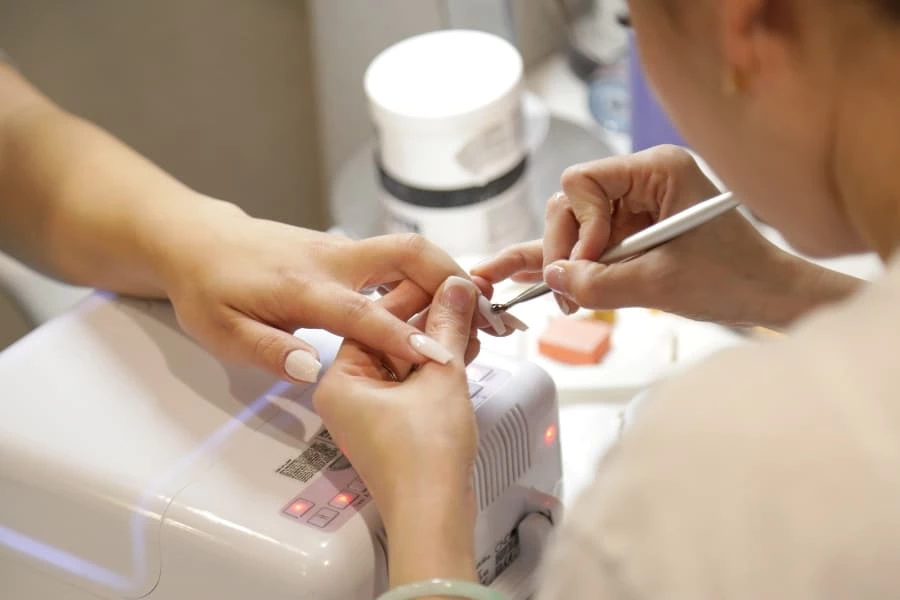Do you have a tube of nail glue that is hard to open? Maybe you can’t get the cap off at all. If so, don’t worry – you’re not alone.
This is a common problem, but there is a solution. This blog post will teach you how to open nail glue quickly and easily. Follow these simple steps, and you’ll be able to start using your glue in no time.
What Is Nail Glue?
Nail glue is a type of adhesive used to attach artificial nails to natural nails. You can also use it to repair broken nails. Nail glue usually comes in a tube and is applied to the nail bed with a brush. It dries quickly and forms a strong enough bond to last for several weeks.
There are two types of nail glue: cyanoacrylate and polyurethane. Cyanoacrylate is a type of plastic that forms a strong bond when it comes into contact with water. Polyurethane, on the other hand, is a type of rubber that is resistant to heat and chemicals. It usually lasts longer than cyanoacrylate.
Nail glue is available in both drugstores and beauty supply stores. Anyone can use it, but it is not ideal for people with sensitive skin or allergies to cyanoacrylate.
When using nail glue, be sure to follow the instructions on the package. Do not use too much glue, as it can make the nails challenging to remove. Do not apply glue to the cuticles, as it can irritate. If you experience any adverse reactions after using nail glue, stop using it and consult a doctor.
How To Open Nail Glue
There are several ways to open nail glue. But first, you will need to loosen the lid. Here are ways you can do this: We will look at each of them in detail:
Using hot water
Some people find that hot water is the best way to loosen the lid. Pour some boiling water onto a towel and place the glue bottle in it for a few seconds. The heat will help soften up the adhesive, making it easier to open.
Be careful not to pour too much water on the bottle, or you could end up ruining the glue. You could also submerge the bottle in a hot bath if you don’t have a towel available.
Using vinegar
Another way to loosen the lid is by using vinegar. Pour some vinegar onto a cloth and wrap it around the bottle. Leave it in for a few minutes, and then open the glue.
The vinegar will help break down the adhesive, making it easier to get off the lid.
Using acetone polish remover
If you have acetone polish remover handy, you can also use that to loosen the lid. Put a small amount of the remover onto a cloth and wrap it around the bottle. Leave it in for a few minutes, and then open the glue. The acetone will help dissolve the adhesive, making it easier to remove.
Once the lid is loose, the next step is to open it. You can do this in several ways:
Using a knife
If you have a sharp knife, you can use that to pry the lid open. Slide the blade between the cover and the bottle, and apply pressure. The knife will help break the glue seal, making it easier to open.
Using pliers
Another way to open the lid is by using pliers. Grip the top with the pliers and twist it until it comes off. When using this method, be careful not to damage the bottle.
Using your hands
The simplest way to open the lid is by using your hands. Grip the sides of the top and twist it until it comes off. This can be difficult, so you may need to use some force. Be careful not to cut yourself on the lid.
Using scissors
If you have a pair of scissors, you can use them to open the lid. Cut along the edge of the cover until it comes off. When using this method, be careful not to cut yourself on the blade.
Once the lid is off, you can start using the glue. Be sure to close the bottle tightly after each use so that the adhesive doesn’t dry out. These are methods you can use to open nail glue. Try them out and see which one works best for you.
Tips When Using Nail Glue
- When using nail glue, make sure to have a well-ventilated area. The fumes can be harmful if breathed in for prolonged periods.
- Avoid getting the glue on your skin, as it can be difficult to remove. If you get the glue on your skin, use acetone to remove it.
- If you are using nail glue to attach a fake nail, make sure the surface of the artificial nail is clean and dry before applying the glue.
- Wait for the glue to dry completely before touching anything. The nails will be stronger once the glue dries completely.
- If you accidentally get nail glue on your natural nails, wait for it to dry and then buff it off. Do not peel it off, as this can damage your nails.
- Nail glue can be used to attach fake nails or to repair a broken nail. It is a strong adhesive that will hold the nails in place.
- Be careful when using nail glue, as it is a powerful adhesive. If you are not careful, you can damage your nails.
- Make sure to read the instructions on the nail glue before using it. There may be specific directions you need to follow to ensure proper use.
- Nail glue is a great way to secure fake nails, but it should not substitute for a true nail file. If you are using nail glue to attach fake nails, use a file to shape them correctly.
- Nail glue can be messy, so it is a good idea to have some acetone on hand in case of any accidents.
- Be patient when using nail glue. It may take a few tries before you get the hang of it.
- If you are not happy with the results, you can remove the fake nails using acetone.
- Nail glue is a great way to achieve a professional look when applying fake nails. It is strong and durable and will hold the nails in place.
- Make sure to use good quality nail glue to ensure that the nails stay in place. Cheap nail glues may not work and can cause the nails to fall off.
- Always test the nail glue on a small area before applying it to your nails. This will help to ensure that there are no adverse reactions.
- Nail glue is available in both a liquid and a paste form. Choose the type that best suits your needs.
Factors To Consider When Choosing A Nail Glue
There are a few factors that you should consider when choosing nail glue. The first is the type of glue. There are two types of glues: solvent-based and water-based.
Solvent-based glues are more durable and last longer, but they can also be more toxic. Water-based glues are not as durable, but they are less harmful.
The second factor to consider is the strength of the glue. Some glues are stronger than others. If you have weak nails, you will need a stronger glue to keep your nails in place.
The third factor to consider is the colour of the glue. Not all glues come in every colour, so you will need to choose the colour that best matches your nails.
The fourth factor to consider is the price. Glue can vary in price, so you will need to find one that fits into your budget.
Choose the glue that is best for you by considering these four factors.
Nail Glue FAQs
What is nail glue made of?
Most nail glues are a form of cyanoacrylate, an adhesive that dries quickly when it comes in contact with moisture. This makes it ideal for bonding nails together.
What are the benefits of using nail glue?
Some benefits of using nail glue include that it is strong and durable, dries quickly, and can be used to bond a variety of materials together.
Is there a specific type of nail glue I should use?
There is no one specific type of nail glue best for everyone. However, some glues are made more durable than others, so it is essential to consider what you will be using the glue for before purchasing.
Can I use nail glue on my nails?
It is best that you not use nail glue on your nails. Doing so can result in weakened or damaged nails. Instead, try using an adhesive sealant to help keep your nails strong and healthy.
How do I remove nail glue?
Removing nail glue can be tricky, as the adhesive will likely have dried quickly after application. One method that may work is to saturate a cotton ball in acetone and then place it over the nail for a few minutes. This should soften the adhesive and make it easier to remove.
Are there any risks associated with using nail glue?
There are no significant risks associated with using nail glue when appropriately used. However, it is essential to remember that the adhesive can be harmful if it comes into contact with your eyes.
In addition, some people may experience an allergic reaction to cyanoacrylate. If you experience any irritation or discomfort after using nail glue, discontinue use and consult a doctor.
Conclusion
So there you have it! Everything you need to open a bottle of nail glue without any fuss. You can quickly and efficiently get the job done with just a few household items.
The easy-to-follow steps provided in this blog post should help you get started on your next manicure or pedicure project. Make sure to give them a try the next time you find yourself in need of some extra adhesive.
 Being Human
Being Human




